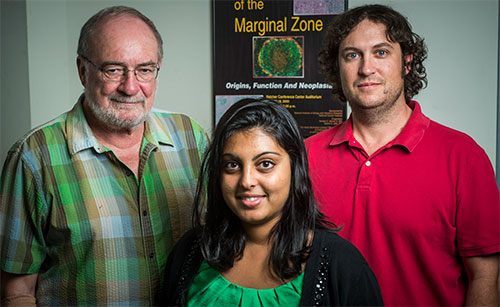 John Kearney (left), Preeyam Patel and R. Glenn KingThe hygiene hypothesis proposes that a 20th century surge in allergies and asthma is because people are living in increasingly hygienic environments. Rather than the rural farm life of the agricultural 19th century, families live in urban and suburban communities, have fewer children who can exchange infections, bathe and wash their hands more frequently, and use antibiotics excessively. This all means reduced infant exposure to microbes that would have tempered excessive immune reactions, such as asthma, later in life.
John Kearney (left), Preeyam Patel and R. Glenn KingThe hygiene hypothesis proposes that a 20th century surge in allergies and asthma is because people are living in increasingly hygienic environments. Rather than the rural farm life of the agricultural 19th century, families live in urban and suburban communities, have fewer children who can exchange infections, bathe and wash their hands more frequently, and use antibiotics excessively. This all means reduced infant exposure to microbes that would have tempered excessive immune reactions, such as asthma, later in life.
In a third publication relating to allergic lung responses, University of Alabama at Birmingham researchers have used an asthma model that lends support to the hygiene hypothesis. They report that asthma caused by adult exposure to cockroach detritus is blocked in mice that were vaccinated as newborns with a particular bacteria.
In this latest study published in The Journal of Immunology, the John Kearney, Ph.D., team has shown that neonatal vaccination using Enterobacter bacteria that express alpha-1,3-glucan molecules on their surface prevents German cockroach-induced asthma as adults. Neonatal vaccination with purified alpha-1,3-glucan was also protective, but vaccination using a strain of Enterobacter that does not express alpha-1,3-glucan was not protective.
Kearney’s previous studies, published in 2012 and 2015, showed that neonatal vaccination of mice with Streptococcus pyogenes and Streptococcus pneumoniae bacteria prevented adult asthma after exposure to the fungal allergen Aspergillus fumigatus and house dust mites, respectively.
“It’s pretty amazing,” said Kearney, a Distinguished Professor in Microbiology in the UAB School of Medicine. “We started doing neonatal immunizations in all three asthma models, and we found that all three were protected against asthma-like symptoms.”
The window to achieve protection remains open for only a short time after birth.
“We do not see protection if we immunize the adults,” Kearney said. “The exposure has to happen early — in human equivalents, probably within the first two years. The kinds of immune cells that appear early in life appear to change later in life.”
Asthma affects more than 25 million people in the United States, including about 7 million children. Exposure to cockroach-derived allergens is associated with severe asthma.
The protective effect of neonatal immunization with Enterobacter appears to be due to selection of a distinct set of immune system B cells that produce IgA antibodies.
“The B cells are in the lungs of the adult mice, waiting and ready,” said graduate student and first author Preeyam Patel. “We think that the IgA binds and inhibits the alpha-1,3-glucan on the cockroach allergen before it can trigger asthma.”
The protective effect of neonatal immunization in the models for A. fumigatus and house dust mite-induced asthma appears to be due to selection of distinct sets of immune system B cells that produce IgM antibodies.
| “We started doing neonatal immunizations in all three asthma models, and we found that all three were protected against asthma-like symptoms.” |
“All three models are B cell-mediated,” Kearney said.
“Based on our understanding of the neonatal mouse B cell response to alpha-1,3-glucan,” the authors write in their paper, “we suggest that therapeutic prophylaxis in the form of a vaccine or probiotic containing alpha-1,3-glucans during early life could be used to modulate neonatal B cells, with the potential for long-lived suppression of asthma development to cockroach sensitization.”
The Patel et al. paper, “Neonatal α-1,3-glucan exposure suppresses cockroach allergy,” is featured in the journal’s “In This Issue” section, which highlights articles considered to be among the top 10 percent of those being published.
Besides Kearney and Patel, R. Glenn King, Ph.D., assistant professor in the UAB Department of Microbiology, is a co-author.
This work was supported by National Institutes of Health grants AI14782-37, AI100005-05 and T32 AI00705, and by the American Asthma Foundation.